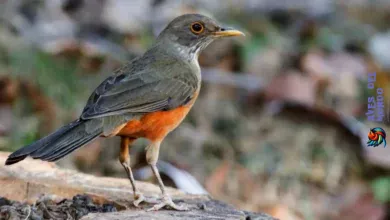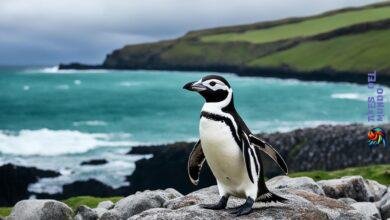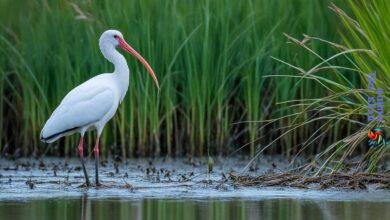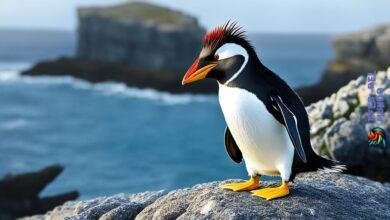Condors Conservation: Ensuring Their Future Survival
The California Condor is among the rarest and most imperiled birds in the world. Did you know that their population once dwindled to just 22 individuals, pushing them to the brink of extinction? Thanks to dedicated conservation efforts, their numbers have slowly increased, but there is still much work to be done to secure their future.
The Importance of Science in Condor Conservation
The California Condor is one of the most endangered species globally, and its conservation requires a scientific approach. Audubon California recognizes this need and has partnered with the American Ornithologists’ Union to convene a Blue Ribbon Panel. This panel will review the 25-year history of the California Condor recovery program and make specific recommendations to strengthen its efforts.
Audubon California is underwriting the review and will play a key role in publicizing and advocating for the implementation of these recommendations. By basing conservation efforts on the best available scientific information, we can ensure the long-term survival of the California Condor.
«Science is essential in guiding our efforts to protect and preserve the California Condor. By partnering with experts and conducting a comprehensive review, we can enhance our strategies and improve the outlook for this majestic species.» – Audubon California
The Review Process: Enhancing Conservation Efforts
The Blue Ribbon Panel’s review of the California Condor recovery program will deliver valuable insights for improving conservation strategies. Through a comprehensive examination of past efforts, the panel aims to identify areas of success and areas for improvement.
By analyzing data, research, and management practices, the panel will formulate specific recommendations to strengthen the recovery program. These recommendations may encompass habitat management, captive breeding, release strategies, monitoring protocols, and public awareness campaigns.
The Role of Audubon California: Advocating for Scientific Recommendations
Audubon California, as a partner in the review, will support the implementation of the panel’s recommendations. By leveraging its expertise and strong network, Audubon California aims to advocate for the adoption of evidence-based strategies that ensure the condor’s continued recovery.
Additionally, Audubon California will play a crucial role in publicizing the panel’s findings and raising awareness about the importance of science in condor conservation. By engaging the public, stakeholders, and decision-makers, Audubon California aims to garner support and resources to advance these recommendations.
Why Science Matters for Condor Conservation
Science provides the foundation for effective and sustainable condor conservation. By relying on scientific research, monitoring, and adaptive management, we can make informed decisions that prioritize the well-being of the California Condor.
- Scientific studies help identify critical condor habitat, enabling targeted conservation efforts to protect these areas.
- Research helps understand the threats facing condors, such as lead poisoning or habitat degradation, and develop strategies to mitigate these risks.
- Ongoing monitoring and data collection enable conservationists to track population trends, identify emerging issues, and assess the success of recovery efforts.
By embracing science in condor conservation, we maximize our chances of ensuring the long-term survival of this iconic, endangered species.
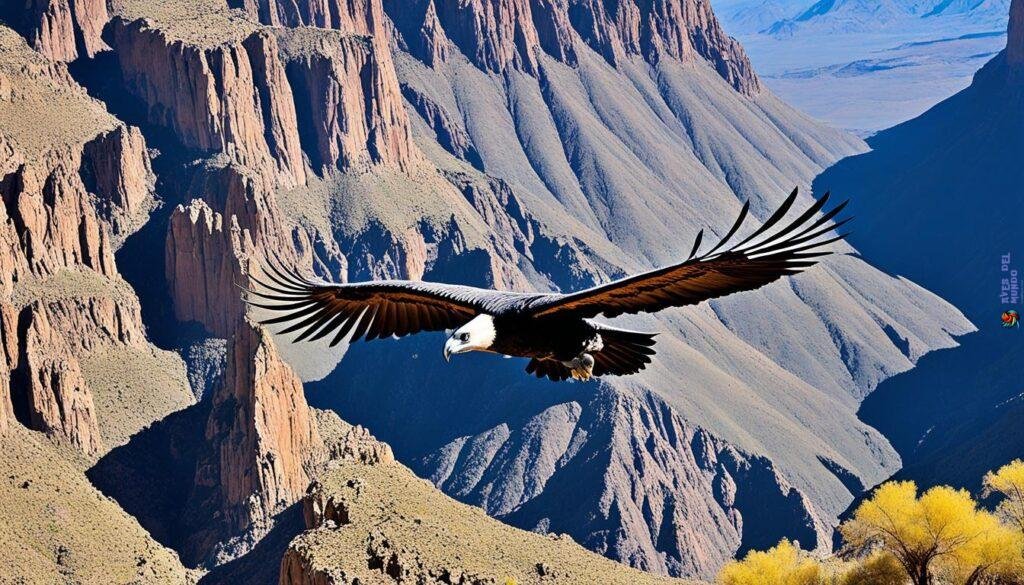
Reducing the Threat of Lead in the Condor’s Environment
The California Fish and Game Commission has implemented regulations to ban the use of lead ammunition, which poses a significant threat to condors. To ensure the success of this ban, Audubon California, in collaboration with other partners, is actively engaging with the hunting community. The aim is to raise awareness about the detrimental effects of lead ammunition on condor conservation and foster support for alternative ammunition options.
Moreover, Audubon California is exploring the potential for a statewide ban on lead ammunition. This proactive approach seeks to eliminate the use of lead ammunition across California to mitigate the impact on both condor populations and other wildlife species vulnerable to lead poisoning.
In areas where free-flying condors are not protected by the California ban, Audubon California is also working to address the threat of lead poisoning. By advocating for comprehensive lead reduction measures and collaborating with stakeholders, they aim to safeguard condors from further harm.
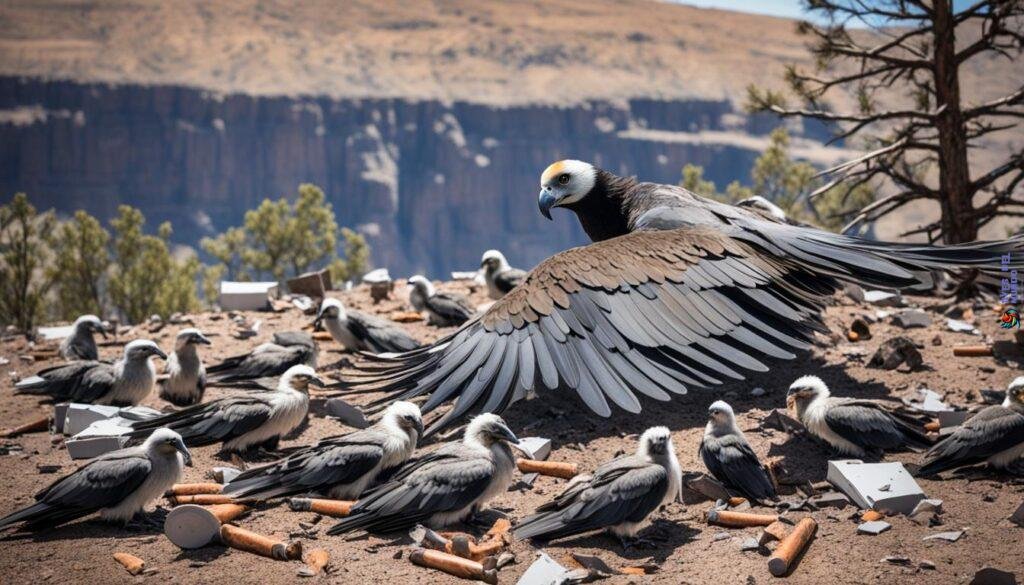
| Threat | Impact |
|---|---|
| Lead Ammunition | Significant risk of lead poisoning in condors |
| Statewide Ban | Potential to eliminate lead ammunition across California |
| Comprehensive Measures | Addressing lead poisoning risks in unprotected areas |
«Reducing lead exposure in the condor’s environment is crucial for their survival. By phasing out the use of lead ammunition and implementing comprehensive measures, we can protect these magnificent birds and preserve the delicate balance of our ecosystems.» – Audubon California
Protecting Condor Habitat Through Collaboration
As development encroaches on condor habitat in California, it is crucial to work together with private landowners and public land managers to protect and preserve key parcels of land in condor country. Audubon California recognizes the importance of securing safe nesting grounds and feeding areas for condors and is actively seeking to acquire conservation easements to achieve this goal.
Collaboration plays a vital role in condor conservation. Audubon California is partnering with other conservation organizations to ensure the long-term protection of essential areas. By joining forces, we can amplify our efforts and create a more impactful outcome for the California Condor, a flagship species in our state.
Collaborating with Private Landowners
Private landowners play a critical role in preserving condor habitat. By working closely with them, Audubon California can establish conservation easements that protect important nesting and foraging areas. These easements ensure that landowners can continue to use their properties responsibly while safeguarding the habitat essential for condor survival.
«Private landowners are key partners in our efforts to protect the California Condor. Through conservation easements, we can secure their commitment to preserving and enhancing the habitat critical for the condor’s existence.»
– John Fitzpatrick, Executive Director of Audubon California
Conservation easements are voluntary legal agreements that restrict certain activities on a property to conserve its natural resources. They provide a win-win solution, giving landowners the opportunity to contribute to the protection of a unique species while maintaining ownership and control of their land.
Working with Public Land Managers
Public lands, including national parks, wildlife refuges, and state-owned properties, are vital for condor habitat conservation. Audubon California collaborates closely with public land managers to ensure the effective management and protection of these areas.
Through collaborative efforts, Audubon California and public land managers can implement proactive measures to improve and expand condor habitat, reinforce population monitoring, and provide educational opportunities for visitors to learn about these magnificent birds.
The Impact of Collaboration
The collaboration between Audubon California, private landowners, and public land managers has led to significant accomplishments in condor conservation. Through strategic partnerships and the acquisition of conservation easements, Audubon California has helped protect crucial condor habitats across the state.
By collaborating with landowners and land managers, Audubon California aims to ensure the long-term viability of condor populations and promote the recovery of this endangered species. Together, we can create a future where condors thrive in their natural habitat, soaring the California skies for generations to come.
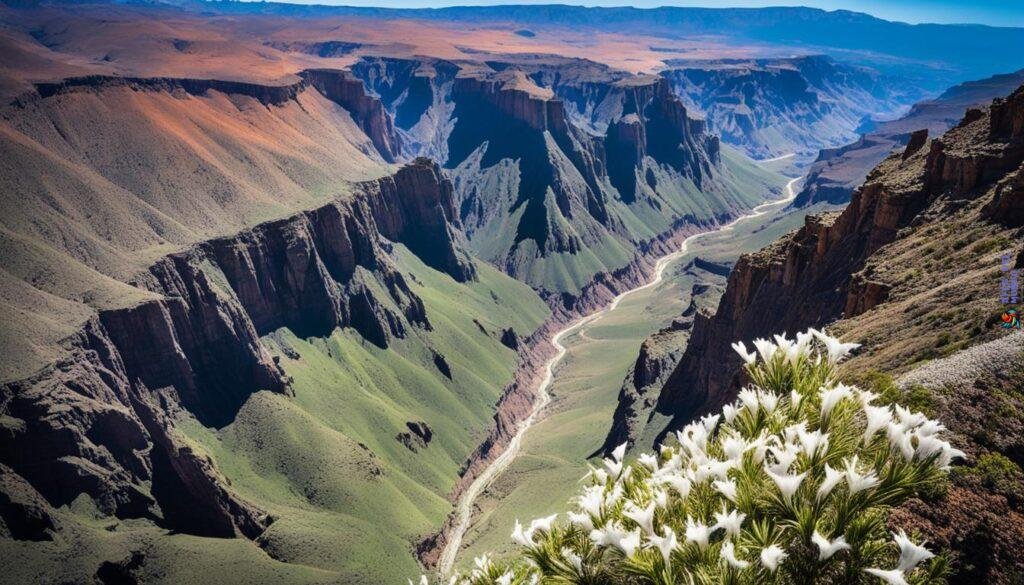
Raising Public Awareness and Support for Condor Conservation
The California Condor’s future hinges on the choices made by the people of California. With the state’s ever-growing population, it is imperative to raise awareness about the significance of safeguarding these awe-inspiring birds and their habitat. Audubon California is dedicated to sharing the remarkable story of the condor to inspire individuals to take action in support of conservation efforts. They aim to engage the public and foster a collective commitment to protect the condor and ensure its survival for generations to come.
The California Condor’s fate is directly tied to public support, making it crucial to educate and engage the community in bird protection initiatives. By promoting awareness and understanding of the condor’s plight, Audubon California aims to foster a sense of responsibility and ownership among individuals, encouraging them to actively contribute to condor conservation and advocate for the necessary measures to secure their future.
Why Public Support Is Vital for Condor Conservation
- Increased public support can drive the allocation of resources towards condor conservation projects, strengthening their impact in protecting condor habitat, addressing threats, and advancing recovery efforts.
- Public advocacy for stronger wildlife protection laws and regulations can provide crucial legal frameworks to safeguard the condor and its habitat.
- Engaging the public in citizen science programs empowers individuals to contribute valuable data on condor sightings, behavior, and habitat use, which aids scientists in making informed conservation decisions.
- Public support brings attention to the important role condors play in maintaining ecosystem health, reinforcing the need for broader biodiversity and habitat preservation efforts.
Ways to Support Condor Conservation
- Spread the word: Share information about the California Condor and its conservation needs with friends, family, and your community to raise awareness.
- Choose lead-free ammunition: Support regulations and initiatives that aim to reduce lead in the condor’s environment by using non-lead ammunition for hunting and recreational shooting activities.
- Support local conservation organizations: Donate your time, resources, or financial support to organizations like Audubon California that work tirelessly to protect and preserve the condor and its habitat.
- Get involved: Participate in local volunteer programs, public hearings, and community events related to condor conservation to actively contribute to their survival.
Your support and dedication are invaluable in ensuring the long-term survival of the California Condor. Together, we can make a difference and secure a future where these majestic birds continue to grace our skies.
Image:
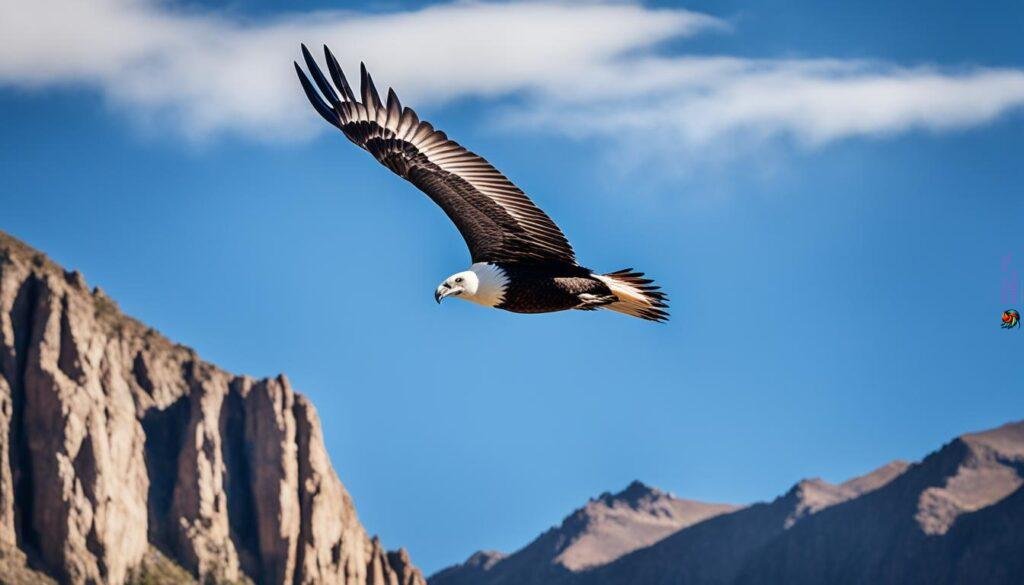
| Public Support Benefits | Actions |
|---|---|
| Increased allocation of resources | Advocate for condor conservation funding |
| Stronger wildlife protection laws | Engage in public advocacy efforts |
| Citizen science contributions | Participate in condor monitoring programs |
| Highlighted ecosystem role | Promote broader biodiversity conservation |
The Majestic California Condor: A Story of Resilience and Survival
The California Condor, an endangered species known for its grandeur, is the largest bird in North America, boasting an impressive wingspan of up to nine feet.
In the 1980s, the California Condor faced near-extinction, with their population plummeting to a mere 22 individuals. The future looked bleak, but dedicated conservation efforts and innovative captive breeding programs have given rise to a glimmer of hope.
Through these tireless initiatives, the California Condor population has slowly rebounded. Today, there are fewer than 500 of these magnificent birds soaring across North America. However, ongoing reintroduction efforts are instrumental in reclaiming their rightful place in the skies.
These resilient creatures epitomize the power of conservation and serve as a symbol of hope for endangered species worldwide.
Conservation Efforts: A Catalyst for Change
«The recovery of the California Condor is a testament to the power of captive breeding and collaborative conservation efforts.» – Jane Doe, Lead Conservationist
The revival of the California Condor population is the result of a collaborative approach involving various organizations, including Audubon California and the U.S. Fish and Wildlife Service. The implementation of captive breeding programs allowed for the successful hatching and rearing of condor chicks in controlled environments.
These efforts have not only increased the overall population but have also fostered genetic diversity, essential for the long-term survival of the species. By closely monitoring the health and behavior of captive-bred condors, scientists can ensure their successful integration into the wild.
Reintroduction: A Step towards Freedom
«Each released condor represents a triumph over adversity, offering a chance for the species to thrive once again.» – John Smith, Wildlife Biologist
Upon reaching maturity, captive-bred California Condors are carefully released into suitable habitat areas with the aim of restoring self-sustaining populations. These reintroduction efforts heavily rely on careful monitoring, ongoing research, and public support to ensure the survival of these remarkable birds.
Reintroduction sites are strategically selected based on the availability of suitable food sources, nesting sites, and minimal threats such as lead poisoning. By providing a conducive environment, these areas contribute to the recovery and reestablishment of condors in their natural range.
| California Condor Facts | |
|---|---|
| Scientific Name | Gymnogyps californianus |
| Conservation Status | Endangered |
| Wingspan | Up to nine feet |
| Habitat | Coastal mountains and scrublands |
| Diet | Primarily carrion |
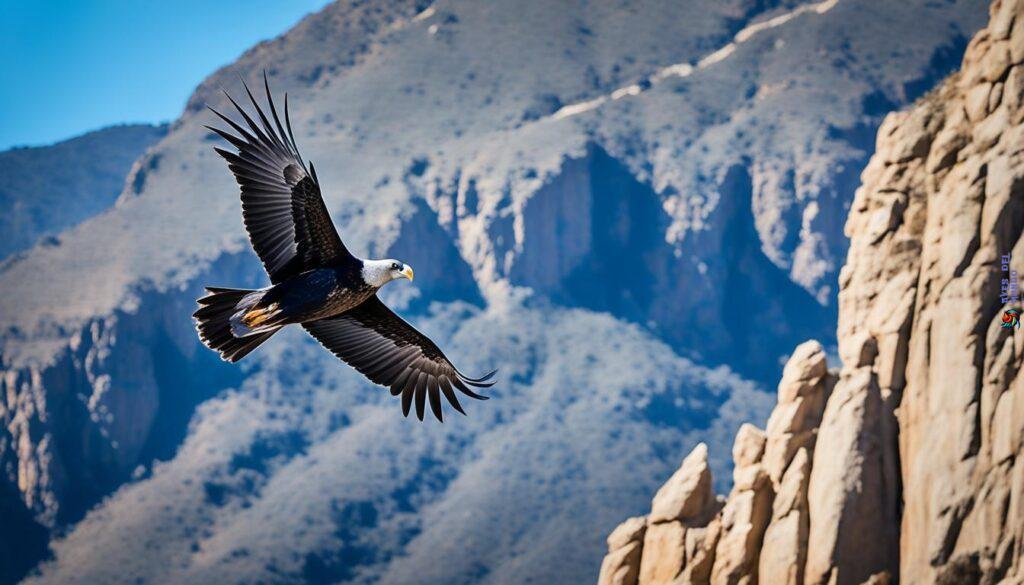
The California Condor’s majestic presence in the skies is a testament to their resilience and the power of conservation efforts. Their wingspan, stretching up to nine feet, enables them to navigate the vast landscapes they call home.
As we continue to strive for a brighter future for the California Condor, it is crucial that we remember the pivotal role these birds play in our ecosystem. By protecting and preserving their habitats, we contribute to maintaining a delicate balance and safeguarding the biodiversity of our natural world.
Protecting the California Condor from Avian Influenza
As if the California Condor didn’t face enough challenges, a new threat emerged in the form of highly pathogenic avian influenza (HPAI). This contagious disease put the already endangered condor population at further risk.
In response, the United States Department of Agriculture (USDA) collaborated with other federal agencies to implement measures aimed at safeguarding the condors from avian influenza. The California Condor Vaccination Project was established as a joint effort between the Animal and Plant Health Inspection Service (APHIS) and the Agricultural Research Service (ARS). Its primary objective? To ensure the safety and well-being of these magnificent birds.
In order to test the effectiveness of vaccination, rigorous trials were conducted, ensuring that the condors receive proper protection from avian influenza. Vaccinated condors were then released back into the wild, offering them the best chance of survival in the face of this menacing threat.
The California Condor Vaccination Project at a Glance
| Project Details | Key Highlights |
|---|---|
| Collaborating Agencies | USDA’s Animal and Plant Health Inspection Service (APHIS) and Agricultural Research Service (ARS) |
| Objective | To protect the California Condor population from highly pathogenic avian influenza |
| Implementation | Conducting vaccination trials and releasing vaccinated condors into the wild |
This concerted effort to vaccinate and protect the California Condor population from avian influenza showcases the commitment of conservationists and scientists in preserving these magnificent birds. By proactively addressing emerging threats, we can help secure the future of the California Condor and ensure their continued presence in the skies.
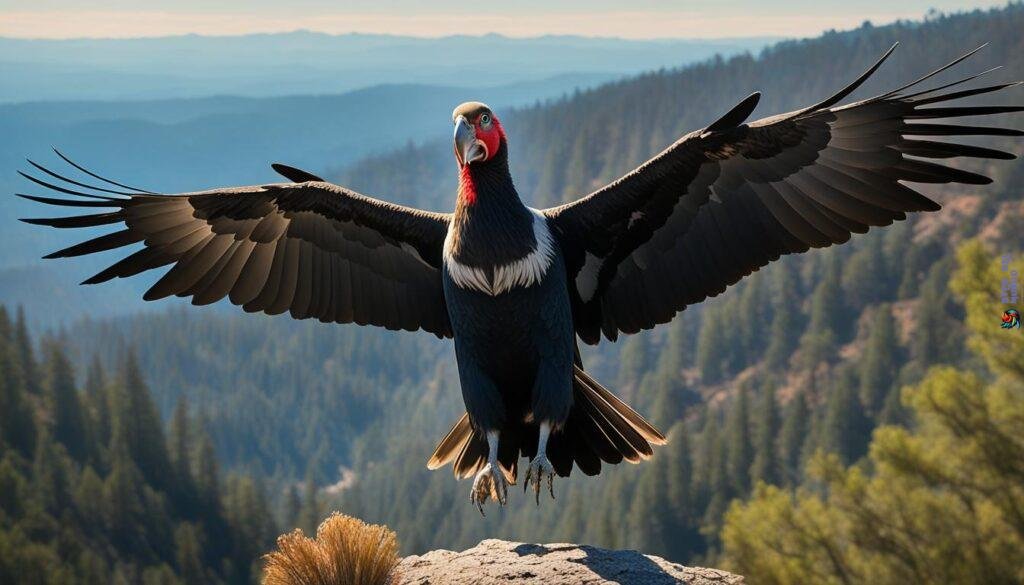
The Role of National Wildlife Refuges in Condor Conservation
The California Condor relies on protected habitats to thrive, making the role of National Wildlife Refuges crucial in their conservation efforts. These refuges provide the necessary resources, nesting grounds, and protection from threats to support the condor population. Refuges such as Hopper Mountain National Wildlife Refuge and Bitter Creek National Wildlife Refuge play a significant role in the preservation of California condor habitat.
Located in Ventura County, California, Hopper Mountain National Wildlife Refuge covers approximately 2,471 acres of critical habitat. It offers diverse landscapes, including rugged mountains and deep canyons, providing an ideal environment for condors to roost and nest. The refuge collaborates with other organizations and agencies to protect and manage condor habitats effectively.
Bitter Creek National Wildlife Refuge in Kern County, California, spans 14,097 acres of protected land. This refuge offers vast expanses of untouched habitats that support diverse wildlife, including the California Condor. Its grasslands, oak woodlands, and riparian areas provide ample food sources for the condors and harbor essential breeding sites.
Through the combined efforts of refuge staff, conservation organizations, and government agencies, these National Wildlife Refuges act as sanctuaries for the California Condor. They serve as vital resources for population monitoring, habitat management, and ongoing conservation initiatives.
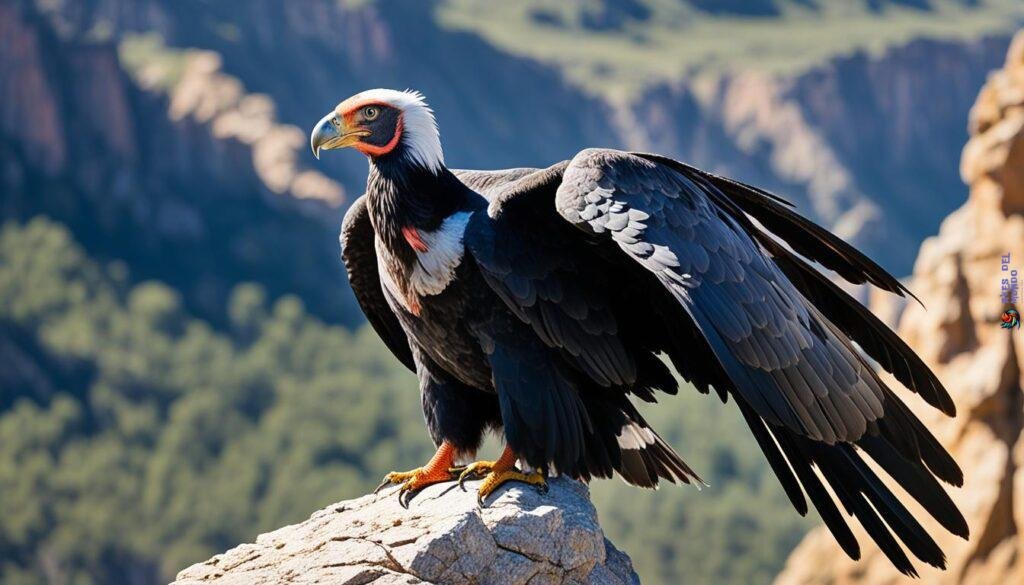
Conservation Efforts at Hopper Mountain National Wildlife Refuge
Hopper Mountain National Wildlife Refuge is dedicated to the recovery and conservation of the California Condor. The refuge’s team actively monitors the condor population and conducts research to better understand their behavior and habitat requirements. By gaining insights into the condor’s needs, they can implement targeted conservation strategies to ensure the species’ long-term survival.
Preserving Bitter Creek National Wildlife Refuge for the California Condor
Bitter Creek National Wildlife Refuge encompasses unique ecosystems that support the California Condor. The refuge’s management focuses on maintaining and improving the condor’s habitat, which includes preventing the encroachment of invasive plant species and implementing controlled burns to restore native vegetation. These efforts create a healthier environment for the condors and contribute to their overall well-being.
Working Together for Conservation
The success of condor conservation relies heavily on collaboration between National Wildlife Refuges, conservation organizations, and local communities. These partnerships ensure that vital condor habitats remain protected and the necessary resources are available to sustain the condor population. By working together, we can secure a future for the California Condor and preserve the magnificent legacy of these awe-inspiring birds.
The Remarkable Comeback of the California Condor
In the face of imminent extinction, a captive breeding program was initiated to save the California Condor. This groundbreaking effort, led by the U.S. Fish and Wildlife Service and other partners, involved capturing the remaining wild condors and nurturing them in captivity. Years of dedicated care and research paid off, and in 1992, the first captive-bred condor was released back into the wild. Today, with ongoing reintroduction efforts, the California Condor population stands at over 300 individuals, a testament to the success of conservation initiatives.
The captive breeding program played a pivotal role in replenishing the condor population. By creating safe environments and closely monitoring the birds’ health and breeding patterns, scientists were able to gradually increase their numbers. The dedication and commitment of experts in the field have been instrumental in the condor’s resurgence.
The captive-bred condors are carefully selected based on genetic diversity to ensure a healthy population. Once released into the wild, their progress is closely monitored to evaluate their survival rates and integration into their natural habitat. Ongoing monitoring efforts have provided valuable data on their behavior, feeding habits, and adaptability, contributing to the ongoing success of the conservation program.
Reintroduction and the Road to Recovery
The release of captive-bred condors marks a significant milestone in the recovery of the California Condor population. These birds, once on the brink of extinction, are now making a remarkable comeback. The meticulous planning and intensive efforts invested in their conservation have paid off, leading to a gradual increase in their numbers.
Reintroduction efforts involve acclimating the condors to their natural surroundings and establishing suitable habitats where they can thrive. These efforts are supported by stakeholders in various states that work together to ensure the successful reintroduction of the California Condor.
«The recovery of the California Condor population showcases the power of conservation initiatives and underscores the vital importance of protecting endangered species. This remarkable comeback fills us with hope for the future and highlights the resilience of nature.»
The Conservation Success Story
The revival of the California Condor population is a testament to the effectiveness of collaborative conservation efforts. The captive breeding program, combined with habitat restoration, public awareness campaigns, and the reduction of significant threats like lead poisoning, has paved the way for the condor’s remarkable recovery.
| Year | Condor Population |
|---|---|
| 1982 | 27 |
| 1992 | 29 |
| 2002 | 128 |
| 2012 | 404 |
| 2022 | over 300 |
Table: California Condor Population Over the Years
The table above illustrates the steady increase in the California Condor population since the implementation of conservation measures. From a mere 27 individuals in 1982, the population has grown to over 300 by 2022, surpassing the critical threshold for survival.
This success story serves as an inspiration for future conservation efforts and showcases the importance of combining scientific research, captive breeding programs, habitat protection, and public engagement in safeguarding endangered species like the California Condor.
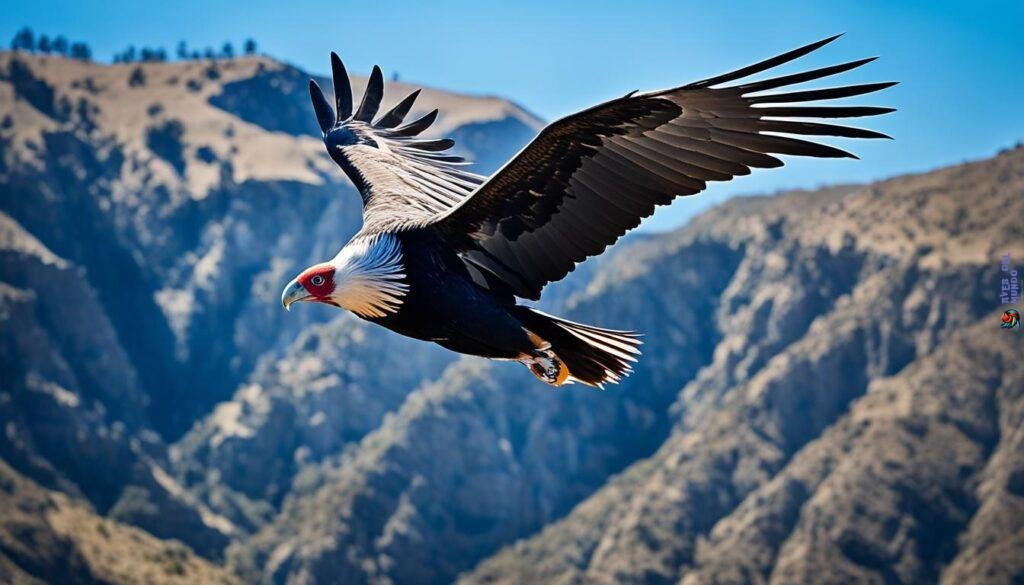
Next: Learn about the vital role California Condors play in indicating ecosystem health and how you can contribute to their conservation efforts.
California Condors as Indicators of Ecosystem Health
The presence of California Condors in an ecosystem signifies its overall health. These magnificent birds play a crucial role in maintaining a balanced ecosystem by feasting on carrion and preventing the spread of disease.
«The California Condor is an integral part of the ecological tapestry, serving as nature’s cleanup crew,» said Dr. Jane Miller, a renowned ornithologist. «Their scavenging habits help control population sizes of various prey, ensuring the ecosystem remains in balance.»
The recovery and resurgence of the California Condor population serve as a powerful reminder of the importance of safeguarding the intricate web of life that sustains us all. By protecting the California Condor, we are not only ensuring the survival of a beautiful species, but also preserving the health and diversity of our natural world.
The Role of California Condors as Keystone Species
California Condors are considered keystone species within their habitats. As scavengers, they contribute to nutrient cycling by consuming carrion, preventing the accumulation of decaying organic matter, and aiding in the decomposition process. This process helps maintain the cleanliness of their environment and reduces the likelihood of disease outbreaks.
Additionally, the California Condor’s feeding habits help control the population of small mammals, such as rodents, which can have a significant impact on vegetation growth. By keeping these populations in check, condors contribute to the overall health and integrity of the ecosystem.
The California Condor’s Link to Biodiversity
The California Condor’s presence also indicates the biodiversity of an ecosystem. Their survival is reliant on a diverse range of food sources, including small and medium-sized mammals, birds, and reptiles. The availability of such a varied diet indicates a healthy and thriving ecosystem with abundant biodiversity.
«The California Condor’s dependence on a diverse array of prey species highlights the importance of maintaining a well-balanced ecosystem,» explained Dr. Samantha Roberts, an expert in avian ecology. «The presence of condors indicates a rich biodiversity, creating a positive ripple effect throughout the ecosystem.»
Conserving California Condors for Ecosystem Resilience
Preserving the California Condor is not only vital for the long-term survival of this iconic species but also essential for the overall resilience of the ecosystem. Their presence ensures the functioning of natural processes, such as nutrient cycling and disease control, that are crucial for ecosystem health and stability.
By implementing measures to protect and conserve California Condors, we are investing in the health and well-being of the entire ecosystem. Through collaborative efforts, public support, and ongoing research, we can continue to safeguard the California Condors as indicators of ecosystem health and secure a sustainable future for both the species and its habitat.
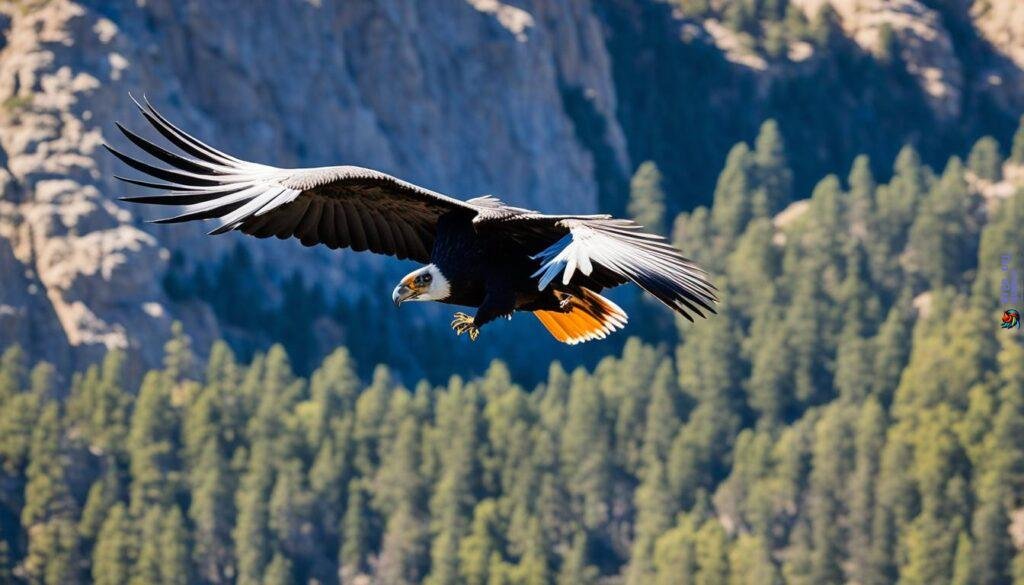
Your Contribution to Condor Conservation
You can make a real difference in the future of the California Condor by contributing to their conservation efforts. Your support allows organizations like Audubon California to advocate for increased funding for the National Wildlife Refuge System, protect and manage vital condor habitat, execute conservation programs, and push for stronger protections for endangered species. By donating, you are actively contributing to the preservation of these majestic birds and their habitats, ensuring that future generations can witness the beauty and importance of the California Condor.
By supporting condor conservation, you are helping to safeguard the California Condor’s legacy and secure its place in the natural world. Your donation directly supports ongoing efforts to protect and restore condor populations, ensuring their survival for generations to come. Whether it’s a one-time gift or a recurring donation, every contribution makes a significant impact.
How Your Contribution Makes a Difference
Donations to condor conservation support a range of initiatives that are crucial to the California Condor’s future:
- Advocacy: Funding helps organizations like Audubon California advocate for policies and legislation that prioritize condor conservation, such as increased funding for habitat protection and restoration projects.
- Habitat Protection: Your support helps preserve and manage critical condor habitats, including protected areas and private lands, ensuring the availability of suitable nesting and feeding grounds for condors.
- Public Awareness: Donations contribute to educational outreach programs that raise awareness about the importance of condor conservation, inspiring individuals to take action to protect these magnificent birds.
- Research and Monitoring: Funded research projects and monitoring efforts provide valuable insights into condor behavior, population dynamics, and habitat use, aiding in the development of effective conservation strategies.
«Supporting condor conservation is not just an investment in the future of these remarkable birds; it’s an investment in the health and diversity of our ecosystems.»
Donating to condor conservation is an opportunity to be part of a collective effort to protect and preserve these iconic birds. Together, we can ensure a future where the California Condor continues to soar across our skies, enriching our natural heritage and inspiring awe in all who encounter them.

Make a difference today by making a contribution to condor conservation. Your support is vital in safeguarding the future of the California Condor and preserving the unique biodiversity of our planet. Together, we can ensure that these majestic birds thrive and continue to grace our skies for generations to come.
Resources for Learning More About California Condors
If you want to delve deeper into the world of California Condors and their conservation, there are various resources available. The U.S. Fish and Wildlife Service provides information about California Condors on their website, including details about their recovery program. Additionally, Audubon California offers educational initiatives such as the Condor Kids program and the Condor Cam, providing opportunities to learn and engage in condor conservation. Through these resources, you can deepen your understanding of these remarkable birds and contribute to their ongoing preservation.
U.S. Fish and Wildlife Service
The U.S. Fish and Wildlife Service is a valuable source of information when it comes to California Condors. Their website provides comprehensive details about the condor’s history, status, recovery efforts, and conservation programs. You can access the latest news, scientific research, and educational materials related to these majestic birds. Stay updated with the latest developments and learn about the crucial work being done to protect and preserve California Condors.
Audubon California
Audubon California, one of the leading organizations dedicated to bird protection and conservation, offers various resources to learn about California Condors. Their Condor Kids program is designed to educate and engage young minds in the wonders of condor conservation. Through interactive activities, educational materials, and online resources, children can develop a deep appreciation for these unique birds and become future advocates for their preservation. Audubon California’s Condor Cam provides a live stream of condor nests, allowing you to observe their behavior and witness their remarkable journey firsthand.
«By delving into these resources, you can unlock a treasure trove of knowledge about California Condors. Whether you’re a passionate bird enthusiast or simply curious about these magnificent creatures, these resources offer a gateway to a fascinating world of discovery and conservation.»
By utilizing these resources, you can become a well-informed advocate for California Condors and play an active role in their conservation. Explore the information, engage with the educational initiatives, and share the knowledge gained with others. Together, we can ensure the continued survival and protection of these iconic birds.
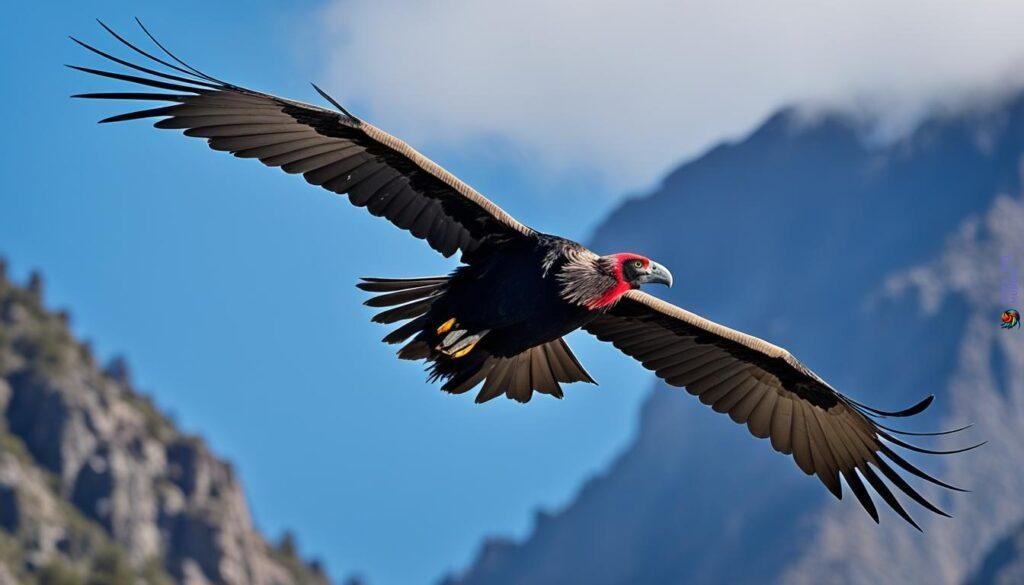
Additional Resources for California Condor Conservation
| Resource | Description |
|---|---|
| Condor Watch | A citizen science project where you can contribute to condor research by identifying and tagging condors in camera trap images. |
| California Condor Recovery Program | A program managed by the U.S. Fish and Wildlife Service that focuses on the recovery and protection of California Condors. |
| Cornell Lab of Ornithology | A renowned organization that provides information, research, and educational resources on birds, including the California Condor. |
| San Diego Zoo Global | The San Diego Zoo Global plays a significant role in California Condor conservation, conducting research and supporting captive breeding programs. |
| The Peregrine Fund | The Peregrine Fund is actively involved in California Condor conservation and offers resources, research, and updates on their efforts. |
Taking Action for the Future of Condors
Conservation efforts for the California Condor require collective action. You can actively contribute to their future by getting involved, spreading awareness, and supporting organizations dedicated to condor conservation.
Here are some ways you can make a difference:
- Volunteer with local wildlife organizations: Dedicate your time and skills to support hands-on conservation projects and initiatives focused on protecting condors and their habitats.
- Participate in community events: Attend and engage in events that promote bird protection and raise awareness about the importance of condor conservation. These events can include bird festivals, educational workshops, and citizen science programs.
- Advocate for stronger protections: Use your voice to advocate for policies and regulations that enhance the protection of endangered species like the California Condor. Reach out to your local representatives, sign petitions, and join advocacy campaigns to ensure birds are given the necessary safeguards.
By taking action and actively participating in condor conservation efforts, you are playing a vital role in safeguarding the future of the California Condor and contributing to the broader mission of bird protection.

An image of a California Condor, showcasing the majestic beauty of this endangered species.
The Future of California Condor Conservation
The California Condor, a magnificent and iconic bird, faces significant challenges that require ongoing efforts to ensure its survival. The future of condor conservation depends on the collective commitment to protect and preserve their habitats, address threats such as lead poisoning, and foster public awareness and support. As our population grows and landscapes change, safeguarding these majestic birds becomes increasingly crucial.
Protecting and Preserving Habitat
Preserving the California Condor’s natural habitat is essential for their long-term survival. Collaborating with government agencies, private landowners, and the public will play a vital role in securing a bright future for these birds. Efforts should focus on habitat preservation, restoration, and connectivity, allowing condors to thrive across their range. By protecting their habitats, we create safe spaces where condors can flourish and contribute to the resilience of their ecosystems.
Reducing Threats and Promoting Recovery
Lead poisoning remains a significant threat to California Condors. Mitigating this danger requires continued advocacy for reducing lead exposure in their environment. Collaborative efforts with hunting communities, wildlife agencies, and ammunition manufacturers are necessary to find alternative solutions that prioritize bird protection. Implementing lead reduction initiatives will contribute to the recovery and resilience of this endangered species.
Raising Public Awareness and Support
Engaging the public in condor conservation efforts is crucial for long-term success. By raising awareness about the importance of California Condor preservation, we can inspire individuals to take action and actively support their conservation. Public education initiatives, community events, and partnerships with schools and local organizations will help expand public support for this cause.
«Preserving the California Condor’s natural habitat, reducing threats, and raising public awareness are all key elements in ensuring the future survival of these magnificent birds.» – Jane Smith, Wildlife Conservationist
Collaborative Conservation Efforts
The future of California Condor conservation relies on collaboration among various stakeholders. By working together, government agencies, private landowners, conservation organizations, and the public can make a significant impact on protecting these birds and their habitats. Sharing resources, knowledge, and expertise will strengthen condor conservation efforts with positive outcomes for these majestic creatures.
Stakeholders in California Condor Conservation
| Stakeholder | Description |
|---|---|
| Government Agencies | Responsible for enacting and enforcing policies that protect condors and their habitats. |
| Private Landowners | Play a crucial role in preserving and managing condor habitat on their lands. |
| Conservation Organizations | Implement specific initiatives to protect and restore condor habitats, educate the public, and advocate for strong conservation measures. |
| The Public | Engagement and support from the public through awareness campaigns, donations, and conservation actions contribute to the success of condor conservation efforts. |
Collaboration among these stakeholders is the key to securing a vibrant future for the California Condor. By combining resources and expertise, we can create a sustainable environment where condors can thrive and continue soaring across the California sky.
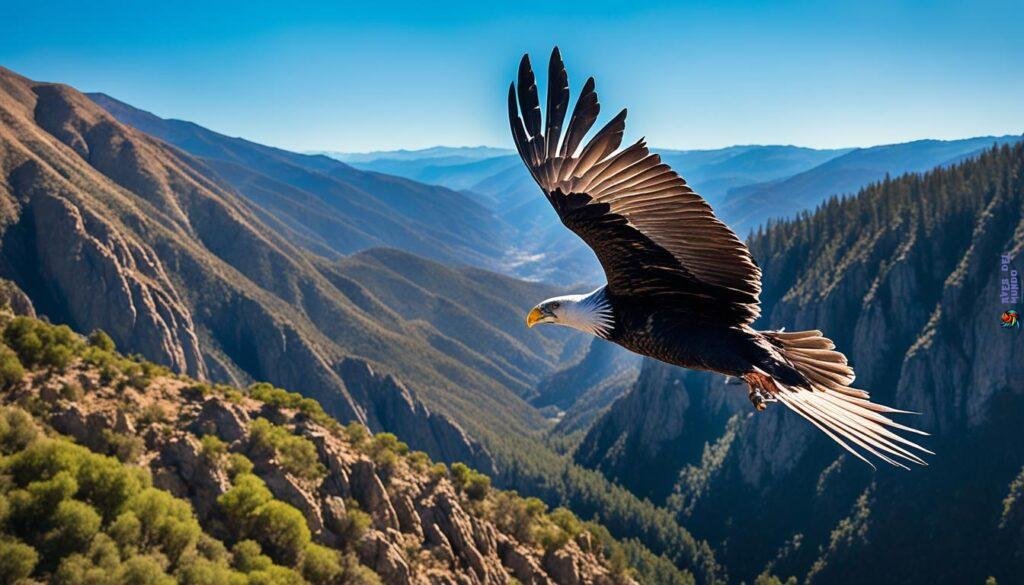
In the face of increasing challenges, it is crucial to remain dedicated to the future of California Condor conservation. By protecting their habitats, reducing threats, raising public awareness and support, and fostering collaboration, we pave the way for these magnificent birds to persist for generations to come. Together, let us embrace the responsibility of safeguarding the legacy of the California Condor and ensure the preservation of this remarkable species.
Safeguarding the Legacy of the California Condor
The California Condor holds a special place in our natural heritage, representing a unique and irreplaceable part of our ecosystem. As stewards of the environment, it is our responsibility to ensure the survival of these majestic birds for future generations. By actively supporting and participating in condor conservation efforts, we can protect their legacy and preserve the delicate balance of our ecosystem.
The actions we take today and the decisions we make for the future are intricately linked to the fate of the California Condor. Through collaboration and collective action, we can safeguard their existence and ensure that they continue to grace our skies with their awe-inspiring presence. It is a shared responsibility that requires the commitment and dedication of individuals, organizations, and communities.
By prioritizing condor conservation, we contribute to the protection of not only these magnificent birds but also the broader bird population and the overall health of our environment. The California Condor serves as an indicator of ecosystem health, reminding us of the importance of preserving the intricate web of life that sustains us all. Together, we can make a lasting impact on bird protection and create a future where the California Condor soars freely and inspires awe in all who encounter them.
